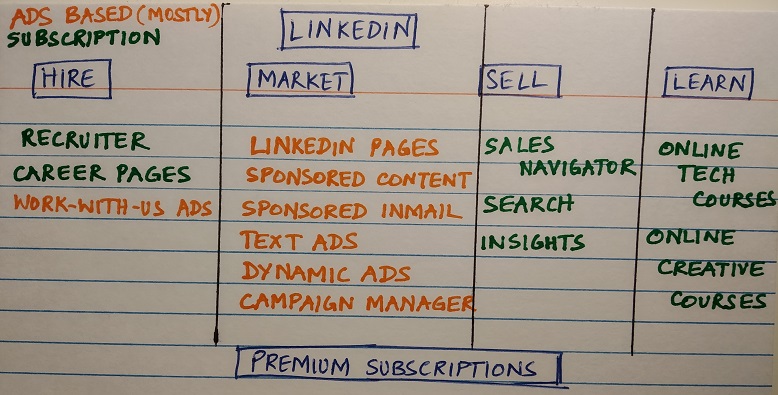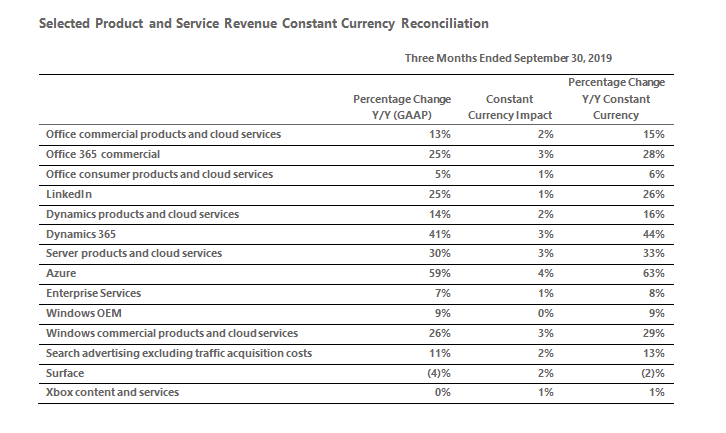LinkedIn's Business →
Lately, I have been reading about several businesses and trying to understand their product offerings, value proposition of the products, business model and how they came to be. With a natural inclination for technology products and a curiosity about startups and business models, this has been an enjoyable learning experience and I am hoping to share a lot of my learning through this medium. Let’s start with LinkedIn.
LinkedIn’s Vision
Create economic opportunity for every member of the global workforce.
- I liked the simple and clear vision statement but was wondering why it mentions only economic opportunity while LinkedIn’s products offer much more or could it be the case that all the benefits the products offer can be tied to economic opportunity? I started researching about what this term economic opportunity entails and found this answer in Quora:
-
When somebody is willing to pay you money for doing something that you are willing and able to do, that is an “economic opportunity”. It can be a small business idea or a job.If you can produce a product or provide a service that people are willing to pay for, that is a small business opportunity. If you have an ability or skill that an employer needs, that is a job opportunity.
-
Basically, an economic opportunity is the chance to do work that somebody is willing to pay you for. You don’t have to “like” the work. You just have to be able to competently do it. If you like your work, all the better for you. But we work to earn money that is paid by other people. The work we do is for other people’s benefit. The money they pay us is for our benefit. It is a reciprocal pay-earn, demand-supply economic relationship. They pay us money for supplying them what they want.
I, however, feel that LinkedIn also provides knowledge opportunity (learning), business/marketing opportunity (sales leads) and career opportunity (jobs for professionals) and talent development (hiring solutions for recruiters) opportunity, etc. There might be some or some aspects of these on which you cannot really put a dollar value on in order for them to be called an economic opportunity.
LinkedIn’s Mission
The mission of LinkedIn is simple: connect the world’s professionals to make them more productive and successful.
Again, a short and crisp mission statement. But, again I believe that the main benefit is making professionals more skilled, equipped, informed, etc., rather than just productive.
LinkedIn’s Products
LinkedIn to many is just a networking site for professionals. But once you look at the suite of products it is much more than that. LinkedIn’s products are organized under four themes:
- Hire
- Market
- Sell
- Learn
The various products under each of these themes are shown below:

It is difficult to categorize each of the products into advertisement-based or subscription-based one as some of them overlap both business models. The HIRE theme is mainly for human resources professionals to track, follow, and manage recruiting pipeline for their organizations. I believe this could be one of the most active products (along with learning) on the platform. The MARKET theme helps in setting up marketing campaigns, reach out to potential resources for marketing purposes, set up custom pages, and serve advertisements on the pages and possibly through emails. Although it sounds like a lot of features, I believe they would have a very stiff competition from the likes of Google and Facebook. Although the advertisements would be more relevant to hiring and professional marketing, the eyeballs on these wouldn’t be as much as on Google search and Facebook feeds. However, with the volume of professionals in the network, hiring ads would get the best reach on this platform. The SELL theme sounds like a specialized Salesforce platform. The LEARN theme is an upcoming Coursera. Although it may not offer a wide variety of specializations for now, with data from the HIRE theme, it would be a more powerful medium for specialized skill development targeted at specific job roles in specific industries. We need to wait and watch how well Microsoft uses the data from one to better the offerings of another. Although LinkedIn membership is free, there is also a premium subscription which could be considered as a separate product in itself (creating significant revenue) and it is needed to use several of the other products, for example InMail.
LinkedIn’s business
- LinkedIn has become a significant business unit of Microsoft. According to a source
-
In the 2019 fiscal year, LinkedIn brought in $6.8 billion worth of revenue, contributing to $38.1 billion of commercial cloud revenue for Microsoft, which in turn made up part of $126 billion total revenue.
Further the numbers below from Microsoft’s earnings and LinkedIn newsroom validate the importance of LinkedIn and its potential.
LinkedIn’s Opportunity

And that shows the opportunity for LinkedIn. Along with the above, GitHub - the world’s largest software development platform or the playground for developers was snapped up by Microsoft. This indicates a very huge potential. The data from HIRE theme above combined with LEARN theme and fueled by GitHub platform is a wonderful growth opportunity. GitHub + LinkedIn for developers would be Instagram for fashionistas and for businesses and recruiters this would be the Instagram for fashion brands seeking ambassadors and influencers. Probably some day very soon let me write about the opportunity for data science and AI in stitching all the above products together as one awesome fabric.
Thats all for now!

